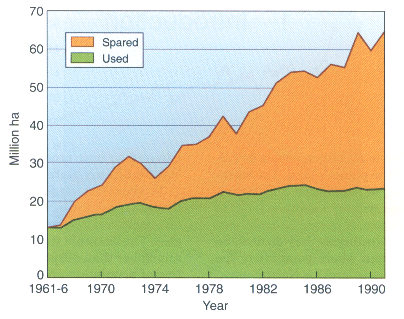Today farmers feed five to six billion people by cultivating about a tenth of the planet's land. The seemingly irresistible doubling of population and the imperative of producing food will take another tenth of the land, much from Nature, if people keep on eating and farmers keep on farming as they do now. So farmers work at the junction where population, the human condition, and sparing land for Nature meet.
The world gives farmers a certain population to feed, and farmers can furnish abundant food or scarcity from either much or little land. By going beyond reporting what has happened or speculating what will happen, agriculturalists can change outcomes. As effective recruits who can make things happen, sparing land rather than merely lamenting loss of Nature, agriculturalists can be drawn into conservation. Agriculture is a participant, not a spectator, sport.
In the eyes of humanity, farmers win the game by growing abundant harvests, dependably and year after year. An abundant harvest is not a sufficient condition for everyone to be well fed, but it is a necessary one. It is the condition humanity depends mainly on farmers to fulfill, while humanity as a whole works to lessen waste and inequity that leave some hungry--even when much is harvested. Although humanity as a whole decides how the pie will be divided, the farmer must first win it. The farmer's success must be tallied in terms of sums and averages. Other things being equal, a larger pie makes larger pieces. And the question is whether winning a pie large enough for ten billion to divide can spare land for Nature.
Arable farming monopolizes my view of sparing land for Nature. Arable is derived from arare, Latin for to plow. Although demands for grazing, lumber, and firewood also press on wilderness, the land spared wholly for Nature, I concentrate on arable farming for three reasons. First, even careful plowing disrupts Nature more than do well managed cattle or chain saws. Second, life's demands for a few thousand calories and a few grams of protein each day from cropland grant no quarter to Nature. Third, envisioning how much cropland and the ten billion will use and so how much land farmers will spare for Nature fills my plate.
To show looking for an answer to the question of
the title is not futile, I conclude my introduction with
an example of how arable land can be spared in a region.
The example should not be surprising when we
remember that, despite the simultaneous multiplication
of population and expansion of cropland globally,
cropland has not expanded as fast as population,
and changes in regional land use do not correlate significantly
with population.![]() My example of sparing
land comes from India.
From 1961-1966 Indian farmers
grew 0.83 t/ha wheat on 13 million ha. During the
next decades, they applied the technology of the
Green Revolution to increase production fivefold. Figure 1.1
shows the expanding area they would have
used to grow the rising production at the 0.83 t/ha of
1961-1966. The land they actually used, however,
expanded by only three-quarters and then leveled off.
The difference between the land actually used and
the land that would have been used at 0.83 t/ha was
spared. Looking back from 1991 to 1961-1966 we see
that Indian farmers spared 42 million ha. Looking
ahead rather than back, I ask, ``How much land can
ten billion people spare for Nature?"
My example of sparing
land comes from India.
From 1961-1966 Indian farmers
grew 0.83 t/ha wheat on 13 million ha. During the
next decades, they applied the technology of the
Green Revolution to increase production fivefold. Figure 1.1
shows the expanding area they would have
used to grow the rising production at the 0.83 t/ha of
1961-1966. The land they actually used, however,
expanded by only three-quarters and then leveled off.
The difference between the land actually used and
the land that would have been used at 0.83 t/ha was
spared. Looking back from 1991 to 1961-1966 we see
that Indian farmers spared 42 million ha. Looking
ahead rather than back, I ask, ``How much land can
ten billion people spare for Nature?"

Figure 1.1. The land that indian farmers
spared by raising wheat yields.
The upper curve shows the area that they would have harvested
at 1961-1966 yields to grow what they produced. The lower
curve shows the area that they actually harvested.
They spared the difference. The figure extends a table compiled
by Borlaug (1987).[Bor87]